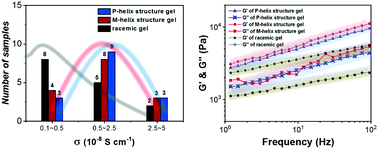Impact of a chiral supramolecular nanostructure on the mechanical and electrical performances of triphenylene-based discotic physical gels†
Abstract
Discotic π-conjugated supramolecular assemblies, especially with chiral supramolecular nanostructures, have been attracting growing research interest due to their significant optoelectronic properties and the possibilities of their applications in the new generation of organic semiconductors. However, the impact of supramolecular chirality on their mechanical and electrical performances remains poorly understood. Herein, a series of optically active supramolecular gels were formed from achiral triphenylene derivatives by introducing limonene as the chiral source. Owing to the well-ordered supramolecular packing, the homochiral supramolecular gels exhibited greater mechanical strength and higher conductivity, compared to heterochiral architectures. The impact of supramolecular packing in homochiral or heterochiral assemblies on their resulting mechanical and electrical performances was investigated in detail, which might be of great fundamental value for the rational design of chiral π-conjugated supramolecular nanostructures for applications in chiral optoelectronics.



 Please wait while we load your content...
Please wait while we load your content...